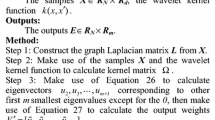Abstract
Extreme learning machine (ELM) has been widely used in various fields to overcome the problem of low training speed of the conventional neural network. Kernel extreme learning machine (KELM) introduces the kernel method to ELM model, which is applicable in Stat ML. However, if the number of samples in Stat ML is too small, perhaps the unbalanced samples cannot reflect the statistical characteristics of the input data, so that the learning ability of Stat ML will be influenced. At the same time, the mix kernel functions used in KELM are conventional functions. Therefore, the selection of kernel function can still be optimized. Based on the problems above, we introduce the weighted method to KELM to deal with the unbalanced samples. Wavelet kernel functions have been widely used in support vector machine and obtain a good classification performance. Therefore, to realize a combination of wavelet analysis and KELM, we introduce wavelet kernel functions to KELM model, which has a mix kernel function of wavelet kernel and sigmoid kernel, and introduce the weighted method to KELM model to balance the sample distribution, and then we propose the weighted wavelet–mix kernel extreme learning machine. The experimental results show that this method can effectively improve the classification ability with better generalization. At the same time, the wavelet kernel functions perform very well compared with the conventional kernel functions in KELM model.


Similar content being viewed by others
References
Liang NY, Huang GB (2006) A fast and accurate online sequential learning algorithm for feed forward networks. IEEE Trans Neural Netw 17(6):1411–1423
Huang GB, Chen L, Siew CK (2006) Universal approximation using incremental constructive feedforward networks with random hidden nodes. IEEE Trans Neural Netw 17(4):879–892
Ding SF, Ma G, Shi ZZ (2014) A novel self-adaptive extreme learning machine based on affinity propagation for radial basis function neural network. Neural Comput Appl 24(7–8):1487–1495
Zhang YN, Ding SF, Xu XZ et al (2013) An algorithm research for prediction algorithm of extreme learning machines based on rough sets. J Comput 8(5):1335–1342
Yang YM, Wang YN, Yuan XF (2012) Bidirectional extreme learning machine for regression problem and its learning effectiveness. IEEE Trans Neural Netw Learn Syst 23(9):1498–1505
Yang YM, Wang YN, Yuan XF (2013) Parallel chaos search based incremental extreme learning machine. Neural Process Lett 37(3):277–301
Ding SF, Zhang YN, Xu XZ (2013) A novel extreme learning machine based on hybrid kernel function. J Comput 8(8):2110–2117
Zhou Y, Hou TS (2013) Detection of line spectrum signal detection based on harmonic wavelet kernel support vector regression algorithm. Comput Simul 30(1):263–267
Wang J, Guo CL (2013) Wavelet kernel extreme learning classifier. Microelectron Comput 10:73–76+80
Cristianini N, Shawe-Taylor J (2000) An introduction to support vector machines and other kernel-based learning methods. Cambridge University Press, Cambridge
Holland JH (1975) Adaptation in neural and artificial systems. MIT Press, Cambridge
Zhong JC (2004) Fault diagnosis study based on wavelet neural network. Ocean University of China, QingDao
Zhang ZG (2005) Research on fault diagnosis based on wavelet neural network. Daqing Petroleum Institute, DaQing
Ding SF, Qi BJ, Tan HY (2011) An overview on theory and algorithm of support vector machines. J Univ Electron Sci Technol China 40(1):2–10
Zhou XY, Ye YZ (2006) Application of wavelet analysis to fault diagnosis. Control Eng China 13(1):70–73
Chen Z (2001) A wavelet neural network based on BP algorithm learning. J Ocean Univ Qingdao 31(1):122–128
Zhu XL, Long YP, Jia L (2007) Traffic volume forecasting algorithm based on RBF neural network. J Shandong Univ 37(4):24–27
Zhang GB (2005) The improvement and application in wavelet neural network. Fuzhou University, Fuzhou
Zhang L, Zhou WD, Jiao LC (2004) Wavelet support vector machine. IEEE Trans Syst Man Cybern B Cybern 34(1):34–39
Ding SF, Wu FL, Shi ZZ (2014) Wavelet twin support vector machine. Neural Comput Appl 25(6):1241–1247
Acknowledgments
This work is supported by the National Natural Science Foundation of China (No. 61379101), the National Key Basic Research Program of China (No. 2013CB329502), and the Basic Research Program (Natural Science Foundation) of Jiangsu Province of China (No. BK20130209).
Author information
Authors and Affiliations
Corresponding author
Rights and permissions
About this article
Cite this article
Ding, S., Zhang, J., Xu, X. et al. A wavelet extreme learning machine. Neural Comput & Applic 27, 1033–1040 (2016). https://doi.org/10.1007/s00521-015-1918-8
Received:
Accepted:
Published:
Issue Date:
DOI: https://doi.org/10.1007/s00521-015-1918-8




